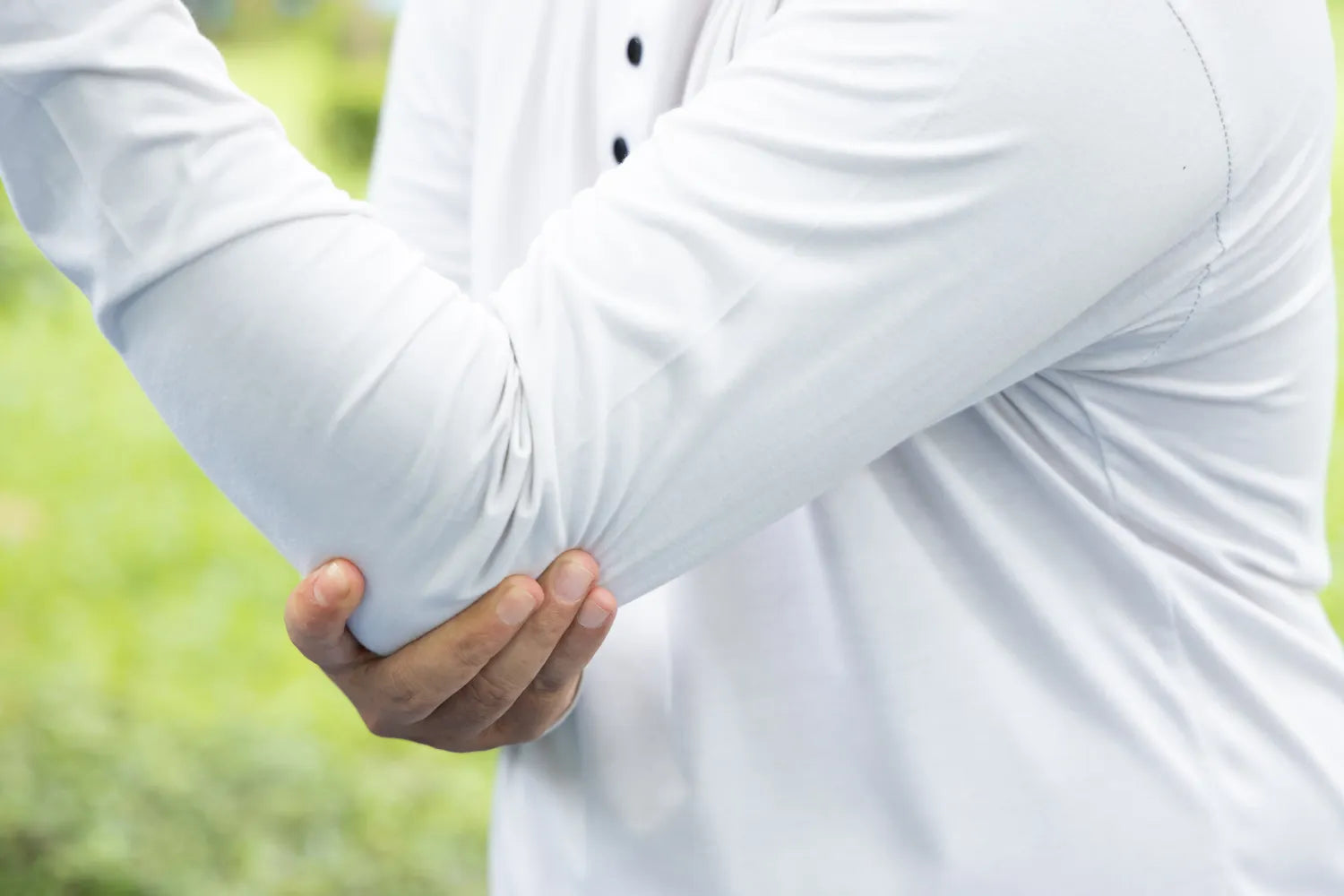Golfer's Elbow: How To Relieve Inner Elbow Pain
When you swing a golf club or perform other repetitive movements, the strain on your forearm muscles and ligaments can lead to a condition known as golfer's elbow, or medial epicondylitis. This common cause of inner elbow pain is more than just a nuisance — it can disrupt your daily activities and quality of life. Not just confined to the greens, this condition can affect anyone who performs repetitive actions with their hands or forearms.
Luckily, there are ways to seek relief from this common condition. Let’s explore them together.
What Is Golfer's Elbow?
Medial epicondylitis, or golfer’s elbow, is a condition that typically results from strain on the forearm muscles and ligaments that control the wrist and fingers. This strain creates tiny tears in the tendons that connect the forearm muscles to the bony bump inside the elbow, causing discomfort.
So, when we talk about golfer’s elbow, we're really discussing the overuse of the elbow joint and the muscles and ligaments surrounding it, which can lead to a reduced range of motion and discomfort during daily activities.
You also don’t need to be an avid golfer to experience golfer’s elbow — any activities that involve repetitive movements of the wrist or clenching of the fingers can contribute to it. This isn't just limited to swinging a golf club or throwing a javelin. It could be anything from typing on a keyboard to using a screwdriver. Over time, these repetitive movements can cause the tendons in the elbow to become inflamed, leading to pain and discomfort.
Understanding these conditions is the first step toward finding effective treatment options. Whether it's physical therapy, strengthening exercises, or anti-inflammatory medication, numerous ways exist to soothe the discomfort and regain your range of motion.
What Are Common Causes of Golfer's Elbow?
Along with overuse and repetitive motions that put a strain on the elbow, certain risk factors can also increase the likelihood of developing this condition. Age is one such factor, as the risk of golfer's elbow increases with age.
Occupations involving repetitive hand or wrist motions, such as construction, painting, or computer work, also pose a higher risk. Additionally, engaging in certain sports, like golf, baseball, or weight lifting, can increase the chances of developing this condition due to the repetitive motions involved.
What Are the Symptoms of Golfer's Elbow?
One of the primary symptoms of golfer's elbow is inner elbow pain. This discomfort can extend along the inside of your forearm and into the wrist, making daily activities difficult. This pain can be especially noticeable when bending the elbow or gripping small objects.
Stiffness in the elbow is another common symptom, often accompanied by a feeling of weakness in the hands and wrists. This can make it challenging to make a fist or grip objects. Some people may also experience a tingling sensation or numbness in the ring and little fingers.
Difficulty moving the elbow, or a reduction in the range of motion, is another symptom associated with golfer's elbow. This can make it hard to fully extend or flex the arm.
Finally, you might experience pain near the funny bone, which is actually the ulnar nerve located on the inside of the elbow. This can also contribute to the tingling sensation in your fingers.
Remember, if you're experiencing any of these symptoms, it's important to seek medical advice. Your healthcare provider can help you understand your symptoms, diagnose your condition, and guide you towards effective treatment options.
Don't let the pain hold you back — get the help you need to regain your range of motion and get back to enjoying your daily activities.
How Is Golfer's Elbow Diagnosed?
When it comes to diagnosing golfer's elbow, your healthcare provider plays an important role. They will first conduct a thorough physical examination, checking for pain in different parts of your elbow, wrist, and fingers. They may also evaluate your grip strength and range of motion.
In some cases, your healthcare provider may order an X-ray to rule out other conditions that could be causing your symptoms, such as arthritis or a more serious elbow injury. While an X-ray won't show Golfer's elbow (since it's a condition that affects soft tissue), it can help confirm the diagnosis by excluding other potential causes.
What Are Other Possible Causes of Elbow Discomfort?
While golfer's elbow is a common cause of inner elbow pain, other conditions can present similar symptoms. Tennis elbow, for instance, can also result in discomfort, but the pain typically occurs on the outside of the elbow rather than the inside.
Bursitis, tendinitis, and ligament sprains are other conditions that can cause elbow discomfort. Your healthcare provider can help determine the exact cause of your symptoms and guide you toward the most effective treatment.
What Are Ways To Get Relief From Golfer's Elbow?
There are several ways to find relief from golfer's elbow, each with its own unique benefits.
Rest
One of the most straightforward ways to alleviate the symptoms of golfer's elbow is to give your body time to heal. Resting the affected arm can reduce inflammation and ease discomfort. During this period, avoid activities that strain your elbow and cause pain.
Rest doesn't mean complete immobility — gentle movements can prevent stiffness and promote healing.
Hot and Cold Therapy
Alternating between hot and cold therapy can be highly beneficial. Cold therapy, such as applying an ice pack, can help reduce inflammation and numb the pain. On the other hand, hot therapy can increase blood flow and relax the muscles, promoting healing.
Typically, it's best to start with cold therapy soon after the onset of symptoms and then alternate with hot therapy as healing progresses.
Use a Splint
Using a splint or brace can provide support and reduce strain on the affected elbow, allowing the tendons to heal. It can also help maintain a neutral position for the elbow and forearm, reducing the risk of further injury. While a splint can provide temporary relief, it's essential to use it as part of a comprehensive treatment plan guided by your healthcare provider.
Over-the-Counter Medication
Over-the-counter (OTC) medications like ibuprofen can temporarily relieve the pain and inflammation associated with golfer's elbow. However, while these medications can help manage the symptoms, they don't address the root cause of the condition.
It's also important to remember that OTC medications aren't suitable for everyone and can have side effects. Always consult with your healthcare provider before starting any new medication.
Stretching Exercises
Stretching and strengthening exercises can play a significant role in relieving the symptoms of golfer's elbow and preventing future occurrences. Regular exercise can help increase the flexibility and strength of your forearm muscles, reducing the strain on your elbow joint.
In some cases, physical therapy may be recommended. A physical therapist can provide guidance on the correct exercises and techniques to promote healing and prevent further injury.
What Is the Role of CBD in Easing Feelings of Discomfort?
Cannabidiol, or CBD, is a natural compound that has gained recognition for its potential to support the body in maintaining a relaxed state. CBD can partner with the body's endocannabinoid system (ECS). This complex cell-signaling system can influence a wide array of functions and processes, including stress, sleep, and how the body signals and responds to discomfort.
The ECS consists of endocannabinoids and cannabinoid receptors. These receptors, particularly CB1 and CB2, are found throughout the body, including in joints and muscles, playing a role in easing feelings of discomfort. Endocannabinoids, produced naturally by the body, bind to these receptors to regulate these processes. CBD mimics these endocannabinoids, potentially enhancing the ECS's functionality.
Topical CBD products can be applied directly to the area of discomfort, making them a convenient option for easing elbow discomfort. By applying the product directly to the affected area, you can target the specific site of discomfort for potentially faster support.
For instance, Muscle MX offers two distinct CBD balms — Activate CBD Balm and CBD Recovery Balm. Activate is a great choice to support muscle health and prepare joints for exercise before working out.
The Recovery balm, with its cooling menthol, provides support after exercising or when feelings of discomfort arise. Both balms can be applied right to the source of discomfort, offering a natural approach to relaxation support.
What Are Some Tips for Preventing Golfer's Elbow?
Preventing golfer's elbow is all about taking care of your body. Proper warm-ups and using the correct technique during physical activities are crucial first steps. Warm-ups prepare your muscles and ligaments for the activity ahead, reducing the risk of overuse injuries.
Strengthening exercises for the upper arm and forearm can also help protect against golfer's elbow. By building strength in these muscles, you can better support the elbow joint and reduce its strain.
Maintaining good posture, both during physical activities and in your daily life, can also help prevent this condition. Good posture helps distribute forces throughout your body, reducing the strain on any one area.
Switching up your workout routine and incorporating rest days can also prevent overuse injuries. Regular breaks from repetitive activities give your body time to recover and heal, reducing the risk of injury.
Managing stress is also key. Chronic stress can negatively impact the immune system and increase the risk of injury. Incorporating stress management strategies, such as mindfulness and yoga, can help maintain a healthy immune system.
By supporting the body's natural stress response, CBD can contribute to overall well-being and potentially ease feelings of discomfort associated with conditions like golfer's elbow.
The Bottom Line
Golfer's elbow, caused by overuse and repetitive movements, can cause significant inner elbow pain. However, with an understanding of the causes, symptoms, and treatment options, you can effectively manage this condition and prevent future occurrences.
Remember, it's okay to seek help. If you're experiencing symptoms of golfer's elbow, reach out to a healthcare provider for guidance. They can help diagnose your condition and guide you towards effective treatment options.
If you’ve consulted your healthcare provider and ruled out serious causes of discomfort, consider exploring CBD products like our CBD balms as part of your support plan for elbow discomfort. These topical products can be applied directly to the area of discomfort, offering a natural approach to supporting your body in maintaining a relaxed state.
Sources:
Golfer's elbow - Symptoms and causes | Mayo Clinic
Tennis Elbow | Mayo Clinic
Ice Packs vs. Warm Compresses For Pain | Johns Hopkins Medicine
Exercises for elbow problems | NHS inform










































